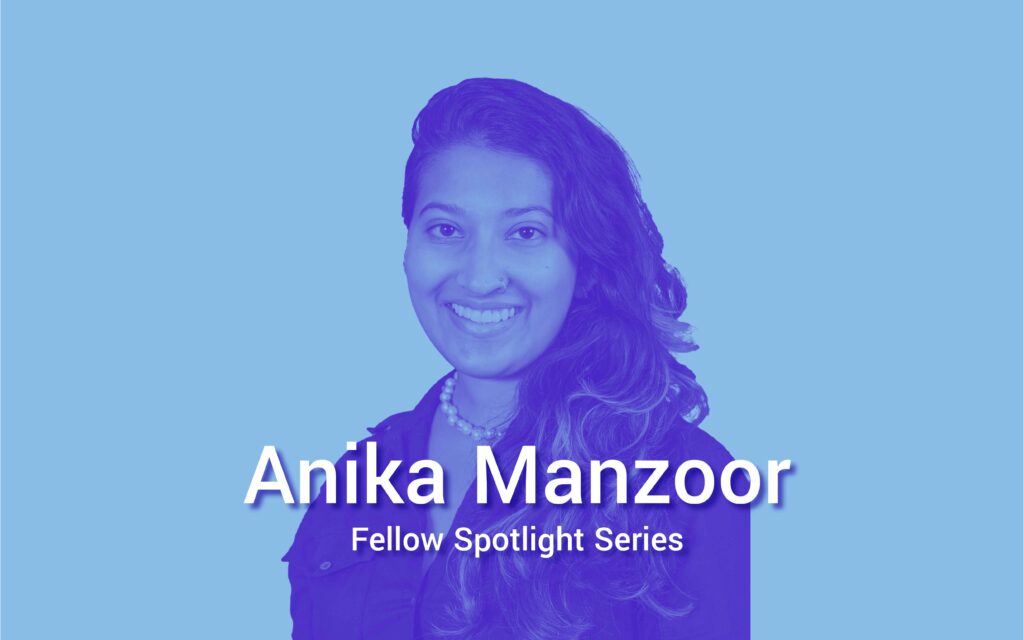Anika Manzoor (MPP ’18, Cheng Fellow) was 12 when she “accidentally” co-founded an advocacy campaign.
It happened in a small cafe owned by her friend’s mother. She had been invited by this friend to learn about the inaccessibility of education for girls in developing countries, especially in Bangladesh — a country Manzoor’s family once called home. She sat with her friends at a small wooden table in the cafe, listening as a woman named Wendy Lesko shared distressing details of the state of education for girls. “I remember the statistic that 100 million girls around the world are denied an education,” Manzoor said.
As the meeting went on, Manzoor and her friends were compelled by what they had learned and were mobilized to take action when Lesko asked a simple question: did they want to become architects to address this injustice? Together, they all set out to form School Girls Unite. At a young age, Manzoor devoted herself to the campaign, becoming a full-fledged activist. “I wasn’t an activist before then,” she said. “But I was now partaking in creating this campaign and learning how to testify in front of Congress and fundraise for scholarships in Mali. We set up a program [in Mali] as well as part of our mission to promote girls’ education globally. It was really empowering to be a part of that process. My actions are now leading to better outcomes.”
Throughout middle school and beyond, Manzoor continued to work closely with her mentor, Lesko, as a part of the organization, the Youth Activism Project. With School Girls Unite as its flagship program, the Youth Activism Project served as an organization to foster movements led by young people. At 13 years old, Manzoor became a founding board member of the Youth Activism Project, as well as a member of the board, a role she held through her college years. “Our mission is to spark youth activists and support them in becoming leaders that drive political and global change,” Manzoor said. “We have a process where Youth Activism Project as an organization supports young people in a variety of means to make change.”
When it came time to pursue her graduate degree, Manzoor found herself at a crossroad. “I considered doing youth development and international relations. But then that ended up coming back to Youth Activism Project and how in my heart all I wanted to do was share that with other people.”
Manzoor came to the Kennedy School with the aim of growing and steering the direction of the Youth Activism Project in order to elevate the way young activists can make their voices heard. In order to achieve this, she began an innovation process of democratizing access to social change resources with a focus on guides to organizing. “In our own analysis, they are not very accessible,” Manzoor said about existing social change toolkits. “They are very dense. They have a lot of valuable information but it’s not user friendly. It’s not addressing user needs in the best way.”
Manzoor set out to establish new resources by and for young people. Although the Youth Activism Project traditionally provided ad hoc support to individual campaigns, Manzoor is now working to codify their expertise into the organization’s “Guide to Change”. Currently, she is working in partnership with other young activists to create a resource with greater accessibility. “We are in the mindset of asking young people what kind of resources they need and what kind of medium it should be in. We have agonized over whether it’s readable or if it has the right amount of information without being too dense.”
The result will be an accessible, multistep text that guides young activists through structuring first meetings, narrowing missions, honing campaigns tactics, and reflecting on achievements. What’s more, the guide strives to work for campaigns of any form.“We are issue agnostic. We want young people to create change around issues that they really care about. Some organizations are focused on providing that first step,” she said. “We are trying to go beyond a lot of organizations in the space in that we are really promoting advanced organizing.”
Manzoor’s work is already reaping tangible results. In an evaluation the organization’s beneficiaries, 93% surveyed said that the Youth Activism Project helped them achieve real change in their communities. The results contrasted indicators at similar organizations with students only believing they could make change. Her experience as a Cheng Fellow has helped Manzoor to continue fostering real change led by youth activists.“Before coming into the Cheng Fellowship, I considered myself a novice to the whole social innovation world. I came out of it feeling like I had a solid and strong foundation on how to be an innovator.”
Manzoor’s role as a young activist has heavily informed her position now at the helm of an organization that empowers other youth movements.
“I feel like anyone who is social innovator is an activist at their core.”
“I feel like anyone who is a social innovator, is an activist at their core,” Manzoor said. “[Social innovation is] coming up with an intervention that is created to really address the issue. What I mean by that is that you’re understanding what’s out there and what’s missing and you are confirming your assumptions by talking with those that are most affected by these issues and engaging with that process. I think social innovation is about engaging people that are affected by a problem to create novel solutions to address the issue.”
“I think social innovation is about engaging people that are affected by a problem to create novel solutions to address the issue.”
Want to connect with Youth Activism Project? Follow them on Facebook or Twitter.

